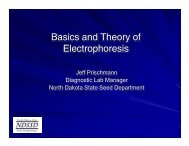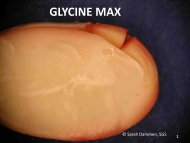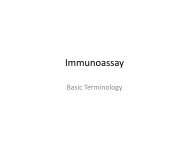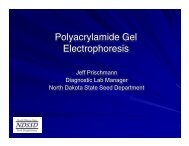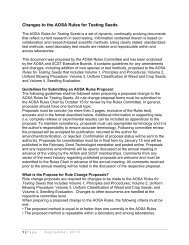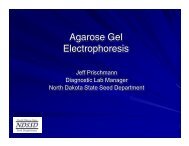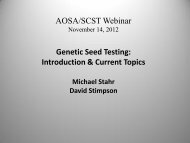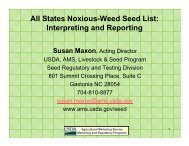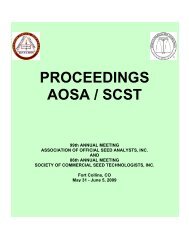Create successful ePaper yourself
Turn your PDF publications into a flip-book with our unique Google optimized e-Paper software.
<strong>Herbicide</strong> <strong>Bioassay</strong> <strong>Testing</strong><br />
2010 SCST <strong>Herbicide</strong> <strong>Bioassay</strong><br />
Workshop
<strong>Bioassay</strong>s<br />
Watch outs<br />
– Distinguishing weak/diseased seedlings<br />
from non-trait<br />
– Uniform herbicide application<br />
– Correct herbicide concentration
<strong>Bioassay</strong> <strong>Testing</strong><br />
1. Mix herbicide<br />
2. Apply to media<br />
3. Place 400 seed<br />
4. Place Negative and<br />
Positive check seed<br />
5. Incubate<br />
6. Evaluate normals,<br />
abnormals using<br />
AOSA Rules for<br />
Germination<br />
7. Report
<strong>Herbicide</strong> Concentrations<br />
Determine optimum ppm<br />
Calculate amount of herbicide & water<br />
100ppm = .01% solution<br />
75% AI = 75/100g is active<br />
500 ml of 100 ppm solution<br />
X=(0.0001)(500ml) / 0.75AI<br />
x=0.0667g of 75% AI
Evaluating <strong>Herbicide</strong> Trait Tests<br />
• Verify negative and positive check seeds<br />
• Evaluate test sample<br />
• Count normal seedlings<br />
• Count non-trait seedlings<br />
• Calculate the percentage of trait seedlings<br />
# trait seedlings<br />
# normal seedlings
Non-Trait Dicot Seedlings<br />
Inhibition of secondary root growth and<br />
hairs<br />
Shortened hypocotyl growth<br />
Browning of root tip and hypocotyl tissue<br />
Inhibition of unifoliate leaf development
Non-Trait Monocot Seedlings<br />
Inhibition of root growth and hairs<br />
Shortened shoot growth<br />
Browning of mesocotyl tissue<br />
Lack of chlorophyll development<br />
Clear coleoptiles with stunted plumules
Liberty Link Corn (96%)<br />
•Inhibition of root growth and hairs<br />
•Browning of mesocotyl tissue<br />
•Inhibition of chlorophyll production & shoot development
Various Growth levels of Non-Trait<br />
Liberty Seedlings
Clearfield Corn (97%)<br />
Non-trait<br />
trait<br />
•Shortened<br />
shoot<br />
growth<br />
•Inhibition<br />
of root<br />
growth and<br />
hair.
Roundup Ready Soybean (99%)<br />
Shortened<br />
hypocotyl<br />
growth<br />
•Inhibition<br />
of root<br />
growth
Roundup Ready Corn (98%)<br />
Nontrait<br />
Trait<br />
•Inhibition of<br />
root hairs<br />
Short stiff<br />
primary root<br />
•Plumule<br />
lacking<br />
chlorophyl,<br />
not extending<br />
to end of<br />
coleoptile.<br />
•Needle eye
STS Soybeans (95%)
Key points<br />
Determine if the seedling is abnormal due to<br />
mechanical injury, physiological decay or<br />
fungal infection OR it is non-trait.<br />
Verify check samples are reacting as expected<br />
and your solution is at the correct<br />
concentration.<br />
Positives can be evaluated with lateral flow<br />
strip test and/or PCR to double check and<br />
determine event.
References<br />
Seed Technologist Training Manual<br />
www.seedtechnology.com<br />
– <strong>Herbicide</strong> <strong>Bioassay</strong> Study Guide<br />
– Non-tolerant Seedling Study Guide
Basics - <strong>Herbicide</strong> <strong>Bioassay</strong><br />
What is it? Exposing seeds or seedlings to a<br />
herbicide solution to determine tolerance to<br />
the herbicide(s) in question.<br />
Methods:<br />
Spray (greenhouse or lab)<br />
Substrate Imbibition<br />
Seed Soak<br />
Combination of methods
Basics - <strong>Herbicide</strong> <strong>Bioassay</strong><br />
<br />
Spray: Spray seedlings with herbicide when seedlings are<br />
approximately 4” tall. After several additional days, examine<br />
seedlings for lesions.
Basics - <strong>Herbicide</strong> <strong>Bioassay</strong><br />
<br />
Substrate Imbibition: Moisten substrate (typically towels,<br />
blotters, or CCP) with herbicide. Plant seeds and “cover”. After<br />
5-7 days look for symptoms of susceptibility.
<strong>Herbicide</strong> added to<br />
tray.<br />
Seed<br />
planted.<br />
Towels added.<br />
Tray to be read.<br />
Substrate Imbibition<br />
Results<br />
Non-tolerant seedlings
Basics - <strong>Herbicide</strong> <strong>Bioassay</strong><br />
<br />
Seed Soak: Imbibe seeds overnight in substrate moistened with<br />
herbicide. Transfer imbibed seeds to water-moistened<br />
substrate. Evaluate after five to seven days for symptoms of<br />
non-tolerance.
Brief History Garst Substrate Imbibition<br />
• Fall 1992 - Stan was asked to develop lab test for<br />
IT/IMI Corn<br />
• Started with substrate imbibition using Pursuit<br />
Solution<br />
• Developed rates and found that test would work<br />
• In 1993 started doing full-scale testing of hybrids<br />
and inbreds.
Making RR Working Solution<br />
dd conc.<br />
erbicide<br />
olution and<br />
ater.<br />
ix well<br />
Roundup Ready Working<br />
Solution made from 50.2%<br />
Roundup Ultra Max
Roundup Working Solution
Filling flask with working<br />
solution
Applying<br />
<strong>Herbicide</strong><br />
Solution<br />
Evenly to<br />
CCP
RR corn tray planted with<br />
colored positive and<br />
negative checks
RR Soybeans planted<br />
With colored<br />
Positive and<br />
Negative checks
Trays planted with plexiglass<br />
over seeds to force contact<br />
with herbicide solution
Soybeans Non-Trait Seedlings<br />
Round up®: 1 o root short, thickened and offcolor.<br />
2 o roots very stubby (if present).<br />
STS®: Unifoliate leaves crossed. No<br />
development of trifoliate leaves<br />
Liberty®: Reduced root development.<br />
Round up® Susc. STS® Susc. Round up® Susc. -spray
Plexiglass<br />
removed on<br />
Day 5
Close-up of<br />
seedlings<br />
after removal<br />
of plexiglass
We read on<br />
day 6.<br />
Negatives<br />
on left,<br />
positives on<br />
right.
Clear example<br />
of STS<br />
negative with<br />
tiny primary<br />
leaves
Another picture<br />
of STS negative
STS Positive
<strong>Testing</strong><br />
conventional<br />
line for RR<br />
presence<br />
One positive
RR soybean test<br />
Of conventional<br />
line.
OOPS. One looks<br />
positive
Liberty corn test<br />
in rolled towels.<br />
neg<br />
Positives with<br />
one clear<br />
negative
Purple seeds are<br />
negative LL<br />
checks
Appears to be LL<br />
negatives.<br />
This is actually<br />
freeze damaged<br />
seed.<br />
We find it very<br />
difficult to<br />
distinguish<br />
freeze damage<br />
from LL<br />
negatives
Canola Non-Trait Seedlings<br />
Round up®: 1 o root short, thickened<br />
and off-color (brown root tip). 2 o roots<br />
very stubby (if present).<br />
Liberty®: Reduced root<br />
Images:<br />
development,<br />
Midwest Seeds Inc.<br />
shortened hypocotyl<br />
Round up® Susceptibles<br />
Liberty® Non-Trait
Canadian Food Inspection Agency<br />
Canola
Non-Tolerant<br />
RR Canola
Corn Non-Trait Seedlings<br />
Glyphosate (Round up®): Reduced root<br />
development; root stiff. Shoot (or leaves)<br />
typically white.<br />
Glufosinate (Liberty®): Reduced root<br />
development. Mescotyl necrotic. “Halo”<br />
effect. Little shoot growth.<br />
Imidazolines (Clearfield®): Reduced root<br />
development.<br />
Round up® Non-Trait Liberty® Non-Trait Clearfield®Non-Trait
Non-Tolerant<br />
Liberty Corn
GT Corn (RR Corn)
Non-Tolerant<br />
Tolerant<br />
Clearfield (IMI) Corn
Non-Tolerant<br />
Clearfield Wheat<br />
Tolerant<br />
Images from Canadian Food<br />
Inspection Agency (CFIA)
Evaluation<br />
<br />
<br />
<br />
<br />
Evaluate RR seedlings by<br />
observing root and shoot<br />
growth<br />
Non-Roundup seedlings<br />
have ¾ inch or less<br />
primary root, no<br />
secondary roots and clear<br />
short coleoptiles<br />
Evaluate IMI seedlings by<br />
observing root growth<br />
Non-IMI seedlings have<br />
retarded root growth and<br />
shoot inhibition<br />
JC Robinson Company
Calculation of Results<br />
Formula:<br />
# of Normal Tolerant => Percent Tolerant<br />
# NT + # Susceptible<br />
400-10(abn)-10(dead)-10(susc) => 370 =><br />
97.4%<br />
370 + 10 380<br />
Rounding: 97.445% = 97.5%, not 98.0%



